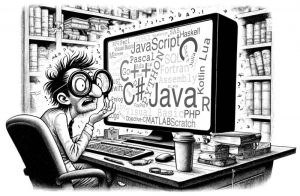Julia. Scala. Lua. TypeScript. Haskell. Go. Dart. Various computer languages new and old are sometimes proposed as better alternatives to mainstream languages. But compared to mainstream choices like Python, C, C++ and Java (cf. Tiobe Index)—are they worth using?
Certainly it depends a lot on the planned use: is it a one-off small project, or a large industrial-scale software application?
Yet even a one-off project can quickly grow to production-scale, with accompanying growing pains. Startups sometimes face a growth crisis when the nascent code base becomes unwieldy and must be refactored or fully rewritten (or you could do what Facebook/Meta did and just write a new compiler to make your existing code base run better).
The scope of different types of software projects and their requirements is so incredibly diverse that any single viewpoint from experience runs a risk of being myopic and thus inaccurate for other kinds of projects. With this caveat, I’ll share a little of my own experience from observing projects for many dozens of production-scale software applications written for leadership-scale high performance computing systems. These are generally on a scale of 20,000 to 500,000 lines of code and often require support of mathematical and scientific libraries and middleware for build support, parallelism, visualization, I/O, data management and machine learning.
Here are some of the main issues regarding choice of programming languages and compilers for these codes:
1. Language and compiler sustainability. While the lifetime of computing systems is measured in years, the lifetime of an application code base can sometimes be measured in decades. Is the language it is written in likely to survive and be well-supported long into the future? For example, Fortran, though still used and frequently supported, is is a less common language thus requiring special effort from vendors, with fewer developer resources than more popular languages. Is there a diversity of multiple compilers from different providers to mitigate risk? A single provider means a single point of failure, a high risk; what happens if the supplier loses funding? Are the language and compilers likely to be adaptable for future computer hardware trends (though sometimes this is hard to predict)? Is there a large customer base to help ensure future support? Similarly, is there an adequate pool of available programmers deeply skilled in the language? Does the language have a well-featured standard library ecosystem and good support for third-party libraries and frameworks? Is there good tool support (debuggers, profilers, build tools)?
2. Related to this is the question of language governance. How are decisions about future updates to the language made? Is there broad participation from the user community and responsiveness to their needs? I’ve known members of the C++ language committee; from my limited experience they seem very reasonable and thoughtful about future directions of the language. On the other hand, some standards have introduced features that scarcely anyone ever uses—a waste of time and more clutter for the standard.
3. Productivity. It is said that programmer productivity is limited by the ability of a few lines of code to express high level abstractions that can do a lot with minimal syntax. Does the language permit this? Does the language standard make sense (coherent, cohesive) and follow the principle of least surprise? At the same time, the language should not engulf what might better be handled modularly by a library. For example, a matrix-matrix product that is bound up with the language might be highly productive for simple cases but have difficulty supporting the many variants of matrix-matrix product provided for example by the NVIDIA CUTLASS library. Also, in-language support for CUDA GPU operations, for example, would make it hard for the language not to lag behind in support of the frequent new releases of CUDA.
4. Strategic advantage. The 10X improvement rule states that an innovation is only worth adopting if it offers 10X improvement compared to existing practice according to some metric . If switching to a given new language doesn’t bring significant improvement, it may not be worth doing. This is particularly true if there is an existing code base of some size. A related question is whether the new language offers an incremental transition path for an existing code to the new language (in many cases this is difficult or impossible).
5. Performance (execution speed). Does the language allow one to get down to bare-metal performance rather than going through costly abstractions or an interpreter layer? Are the features of the underlying hardware exposed for the user to access? Is performance predictable? Can one get a sense of the performance of each line of code just by inspection, or is this occluded by abstractions or a complex compilation process? Is the use of just-in-time compilation or garbage collection unpredictable, which could be a problem for parallel computing wherein unexpected “hangs” can be caused by one process unexpectedly performing one of these operations? Do the compiler developers provide good support for effective and accurate code optimization options?
Early adopters provide a vibrant “early alert” system for new language and tool developments that are useful for small projects and may be broadly impactful. Python was recognized early in the scientific computing community for its potential complementary use with standard languages for large scientific computations. When it comes to planning large-scale software projects, however, a range of factors based on project requirements must be considered to ensure highest likelihood of success.
The post Choosing a Computer Language for a Project first appeared on John D. Cook.
